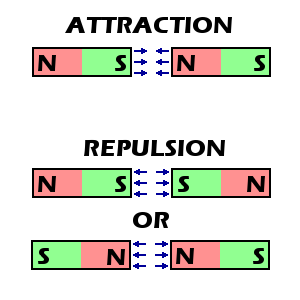Process Skills:
Observation, Classification, Communication, Prediction, Inference, Experimentation, and Defining Operationally.

1. Have all the students stand in a circle facing the center. Explain the rule that if they are facing the same direction they can not touch each other. If they are facing in the opposite direction than their neighbors, then they need to make a connection and hold hands.
2. Have every other child turn around and face away from the center. Ask if the students see any connections that can be made. Have every one face the front again.
3. Repeat the above exercise about three times. Each time use a different pattern of selecting children to face away from the center. (2 in, 1 out) (3 in, 2 out) (etc.). After each selection, ask the students to look for connections that can be made.

4. Have children work in pairs. Assign pairs by telling them to work with the child who sits next to them in classroom. Give each child a magnet and have the pairs “play” with the magnets together. (Refer back to earlier activity) “Think about how your magnet acts with your partner’s magnet.”
A. “Do you notice anything interesting about how the magnets work together?” B. “Do the magnets like each other by going together, or do they act like they don’t want to be together?” “Anyone else notice anything?” C. “Do all of your magnets do that, or do just some of the magnets act that way?”
CONCEPT INTRODUCTION PHASE:
1. “Why do you think the magnets are attracted to each other sometimes, and at other times they don’t want to go near each other?” (Listen to ideas from several students)
2. “We have some words that describe how the magnets are acting. You heard me say that the magnets are ATTRACTED to each other. What does it mean for magnets to be attracted to something?” “The opposite of attraction is called REPULSION, and that means that it pushes away.” Show two magnets being attracted to one another. “I can make the same two magnets show repulsion by turning one of them around like this.” “Every magnet has two POLES, a NORTH pole, and a SOUTH pole. The poles are on the ends of the magnets. Earlier, when I had you hold hands if you were facing in opposite directions, you were acting like magnets, and your hands were the poles. When you were the same, you couldn’t touch, and that is what happens with magnets. The poles have to be different for the poles of two magnets to touch. How many have ever heard the phrase OPPOSITES ATTRACT? That’s a very easy way to remember about magnets. The NORTH POLE always wants to be next to the SOUTH POLE because they are opposites.”




ليست هناك تعليقات:
إرسال تعليق